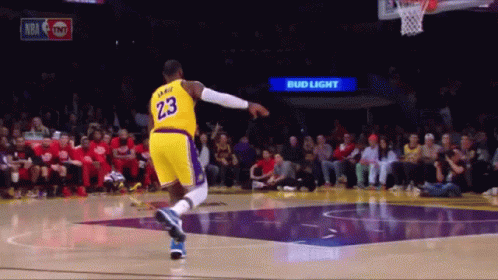What are Plyometrics?
While the benefits of plyometrics have been touted for decades, the definition is debated.
However, most experts agree that it involves the use of what is known as the Stretch-Shortening Cycle (SSC).
This is a process that occurs when the muscles and tendons are forcefully stretched, causing a reaction from both the nervous system and the structures of the joints and muscles, that leads to a higher (and faster) force output than you’d get from simply contracting the muscles.
To illustrate this, you can imagine a car hitting a speed bump, compressing the suspension springs, causing the front of the car to forcefully move upwards.
More specifically, imagine trying to dunk a basketball from standing under the rim versus being able to take a run and spring off the ground.
To get even more specific to plyometric exercises, this generally starts with an initial ‘eccentric’ phase, where a landing causes the joints and muscles to be stretched, storing elastic energy, and sending signals to the nervous system to tell it there is an extreme stretch occurring.
This is followed by what is called the ‘amortisation’ phase where those signals sent to the nervous system cause it to implement a protective reflex known as the myotatic reflex, which causes an involuntary rapid contraction of the muscles.
This reflex is thought to be evolved to protect us during a fall, for example, and it calls on motor units that we usually don’t have voluntary access to.
This can be thought of similarly to the reflex that causes you to retract your hand much more rapidly than you might be able to do voluntarily, when you touch something hot.
This is followed by the ‘concentric’ phase, where the stored elastic energy in the muscles and tendons, along with the involuntary contraction from the myotatic reflex leads to a higher force output at a faster speed (that is, more power), than you would have otherwise been able to create.
What are Plyometrics Good for?
We can think of the benefits of plyometrics in a range of ways, but one useful way is through the lens of a general exercise science principle known as the S.A.I.D. (specific adaptation to imposed demands) principle.
This principle can be basically defined as “You get better at what you practice”.
In the case of endurance running, that might mean you get better at running long distances by running long distances.
In strength training, that might mean you get better at lifting heavy weights by lifting heavy weights.
In the case of plyometrics, we can ask the question, “What is it that plyometrics allow us to do, and therefore get better at?”
In the most general way possible, if we’re doing a lot of powerful movements (by doing more plyometrics) we’re likely to get better at moving powerfully and/or we’ll be able to we’ll be able to use less energy to produce power at lower intensities (potentially improving performance even in distance running, for example).
That will likely mean we’ll get better at doing the specific plyometric exercises themselves, but could also transfer over to other explosive movements that are involved in a sporting context, such as jumping, throwing, and sprinting by:
Increasing our ability to access the previously mentioned high-threshold motor units.
Increasing the rate at which these motor units can be recruited by improving neuromuscular efficiency (improving rate of force development).
Improving our general coordination in movements involved in moving the body quickly through space, through enhancing proprioception (the body's awareness of its position in space) and intermuscular coordination.
Improving the strength/size of the muscles, tendons, and their connections, and the stiffness of the tendon.
In summary, by including more plyometrics, we improve our ability to produce higher forces at higher speeds, while improving coordination and robustness of the tissues involved.
Types of Plyometrics
Similarly to the definition of plyometrics generally, the definition of their subcategories is also debated.
One way is to think of them on a spectrum based on the ground contact time, that is, the amount of time that is spent on the ground in between landing and jumping.
At the top end of that spectrum is what we might call intensive plyometrics like depth jumps, high-intent pogo hops, bounds, and sprints.
The aim with these is to produce the highest force output whilst spending the least amount of time on the ground.
Observe the final few steps, where the foot hits the ground forcefully, and the lower body is ‘loaded up’ before jumping.
These type of plyometrics will generally create more direct adaptations to power output and subsequent sporting improvements, but they are likely to impose a greater recovery demand, so should therefore be introduced more gradually than the following types.
Below that is what we might call extensive plyometrics, which are generally lower-intensity versions of the intensive plyometrics like hops and bounds, but done for higher repetitions, and can also include other repetitive, reactive activities like skipping, for example.
These variations are more focussed on building up the strength and endurance of the tissues involved as well as improving rhythm and coordination, both for the direct benefits, but also as a means to building up the ability to do more intensive plyometrics.
Below that in terms of ground contact time is what we can call deep plyometrics, and this is where we get into a “grey zone” around definitions.
This could include things like Squat or Split squat oscillations, skater hops, as well as squat jumps and split squat jumps.
And whilst these movements have a lot of the characteristics of plyometrics, including a landing a take-off sequence and the intent to move reactively and powerfully, the long ground contact times and the lesser involvement of the tendons mean that most experts would agree that they’re not strictly plyometric movements.
Still, I think it can be useful to include them in the discussion, given that they can be included in the overall training plan in a similar way.
The idea with these movements is to expose the body to the reactive, eccentric-to-concentric process in deeper ranges of motion than usual plyometrics.
This is useful for athletes specifically because increased exposure to these movements prepares the body to perform better and be more resilient for when they encounter these positions in sporting contexts.
This is particularly relevant to instances of deceleration and acceleration, but also in more static instances, where you’re having to push your way out of a tackle, or engage in something like a rugby scrum.
But even for the everyday non-sport athlete, these can be a useful way of warming up for strength training or running, as well as being an alternative way of exposing the body to higher forces in these end ranges without the need for an external object like a barbell.
The grey zone extends further to exercises like box jumps and broad jumps, which again, are focussed on improving one’s power output, so can be included in the discussion, but which stray further from the strict plyometric definition given that they don’t have a landing before the take-off, and technically therefore have an even longer ground contact time, whilst making even less use of the tendons’ effects.
This doesn’t take anything away from their effectiveness within a training plan, given the similarities in terms of benefits to the deep movements.
How to Include Plyometrics in Your Training Program
As with any new addition to a training plan, starting small and building up gradually is advised.
This is certainly the case with plyometrics, given the high forces and novelty involved.
For most people, it could be as simple as adding in 1-2 plyometrics exercises to the start of each gym session and/or sport/running session - This could be incorporated as part of the warm-up, for example.
Starting with lower-intensity variations and building up volume through increasing the number of repetitions per set and the number of times you’re doing them per week will allow you to build up the skill and coordination involved, as well as building up tissue tolerance required.
Again, these alone will bring benefit, but they will also allow you to safely progress to higher-intensity variations over time.
That is not to say that once you progress to higher-intensity variations, that you need to drop the lower-intensity variations, in the same way that you wouldn’t drop all slower running just because you can sprint.
Over time, as you build tolerance and skill, you can start to include more intensive variations, again, building in 1-2 additional plyometrics exercises per session to your existing training plan.
These can also be progressed by adding more complexity, exploring variations in foot positions, movement directions, external objects, and combinations of multiple exercises.
Over time, you may even move towards including sessions to your weekly training schedule that focus exclusively on plyometric-based exercises, but for most, starting to include them to your existing training sessions is sufficient.
This might start with something as small as (after a general warm-up) 2-3 sets of 20 pogos into 2-3 sets of bounding practice.
That might progress to 3 sets of 10 pogos for max height into 3 sets of 10 lateral bounds into 3 sets of 3 deep squat jumps.
Eventually that might progress to something like 3 sets of single leg pogos, 3 sets of high-intent bounds with a run-up, 3 sets of hurdle jumps, and 3 sets of broad jumps.
Of course, it could be progressed beyond that if needed.
These are very vague examples, and each person’s goals, current training schedule, training history, and other factors will majorly affect how these are started and progressed, but the general recommendation of starting with lower intensities, volumes, and complexities, and building these up over time will allow you to reap benefits from the start, while also continuing to progress over time.
Article Written By Conor O’Neill
You can find out more about The Everyday Athlete Program by going to everydayathleteprogram.com/coaching.





